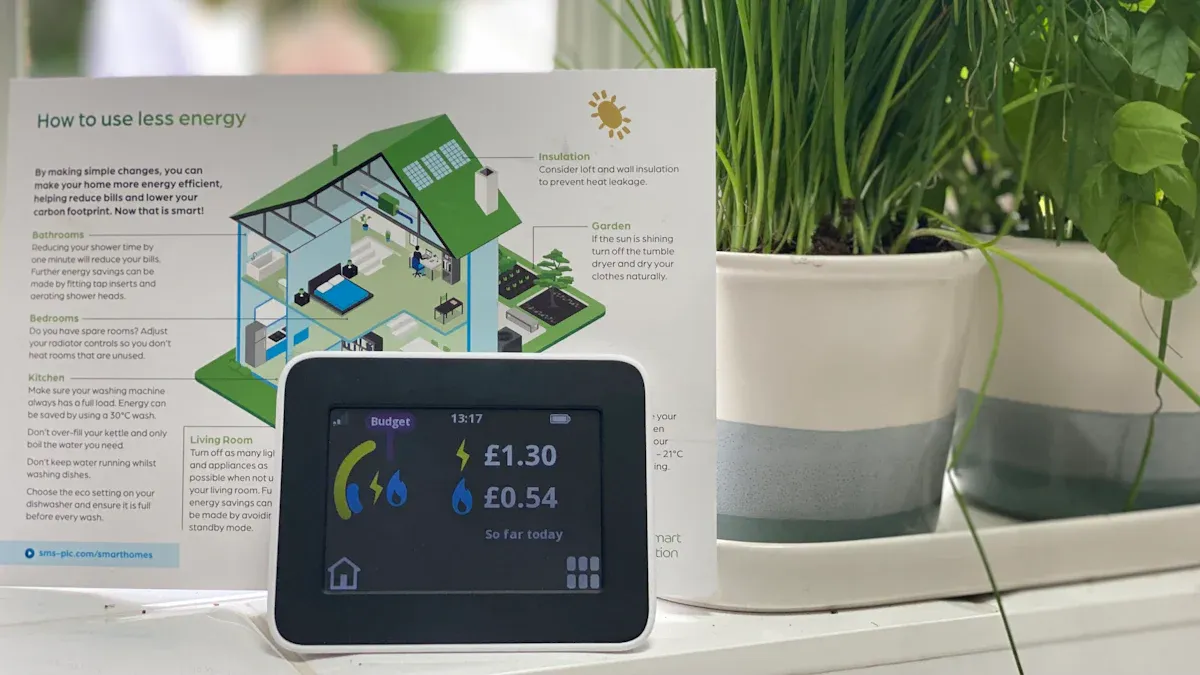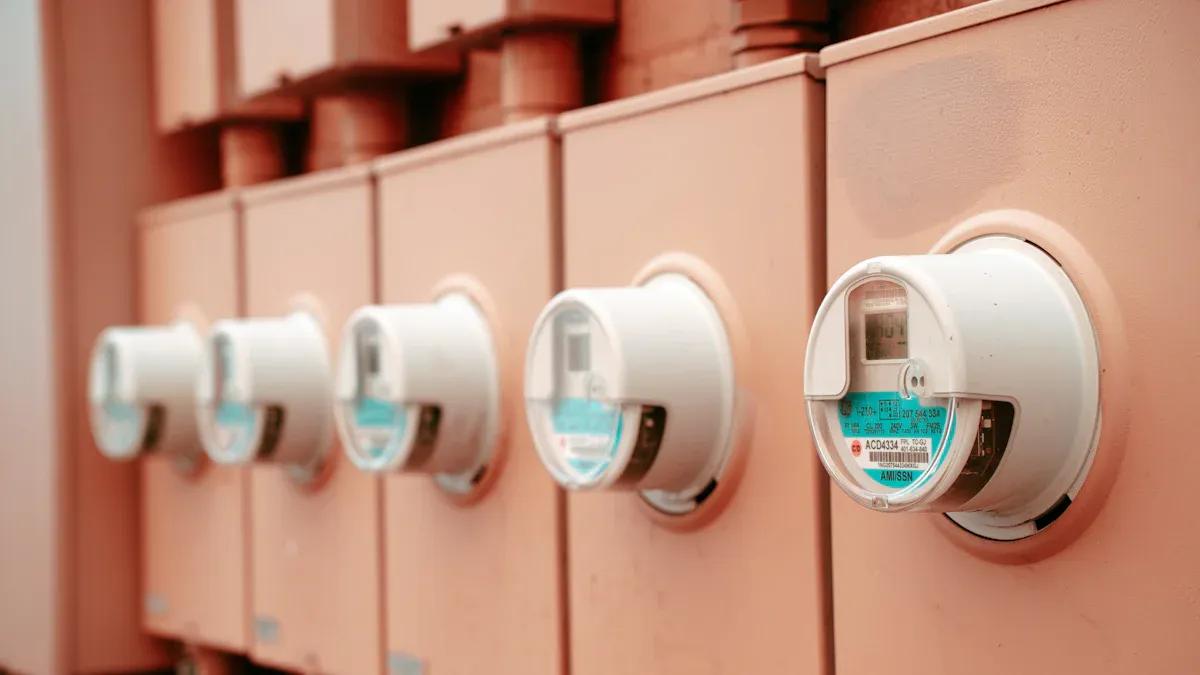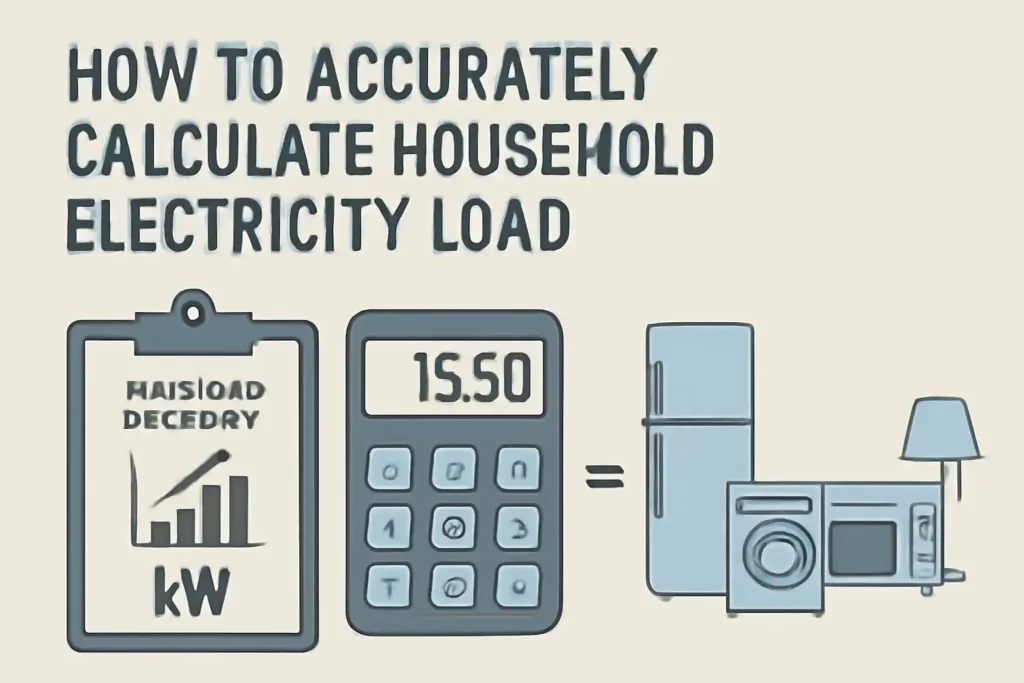Understanding your household electricity load is crucial for effective energy management. This involves knowing the total power consumed by all your devices and appliances. By tracking your household electricity load, you can save money, reduce energy waste, and avoid potential hazards.
Electricity consumption varies from home to home. For instance:
- In 2022, the average U.S. home had a household electricity load of 10,791 kilowatt-hours per year, which translates to about 899 kilowatt-hours each month.
- Homes measuring around 1,818 square feet had a household electricity load of approximately 0.49 kWh per square foot monthly.
- Factors such as home size, location, and the types of appliances significantly influence your household electricity load.
To determine your home’s electricity use, start by listing your appliances. Check the power consumption of each one and sum their wattages. This straightforward approach will help you make informed decisions about energy savings and safety.
Key Takeaways
- Knowing your home’s electricity use can save money and energy.
- Write down all your appliances and their wattage to find total use.
- Check your electricity use often to avoid overloads and stay safe.
- Use energy-saving devices or solar panels to cut costs and help the planet.
- Ask a trained electrician for big changes to stay safe and follow rules.
Understanding Household Electricity Load

What is household electricity load?
Household electricity load means the total energy needed to run everything in your home. Every device, like your fridge or phone charger, adds to this load. There are three main types of loads:
- Resistive loads: These include things like toasters and old light bulbs. They use energy at the same time as voltage.
- Inductive loads: Appliances like air conditioners and fridges fall here. Their current peaks after the voltage.
- Capacitive loads: These help other loads and have current peaks before voltage.
Knowing your household electricity load shows how much energy you use. It also helps you find ways to save energy.
Examples of common appliances and their power consumption
Different devices use different amounts of electricity. Knowing their power use helps you calculate your home’s electricity load. Here’s a table with examples of common appliances:
| Appliance | Minimum Power (W) | Maximum Power (W) | Standby Power (W) |
|---|---|---|---|
| Smoke Detector | 0 | 1 | N/A |
| Soldering Iron | 30 | 60 | N/A |
| Space Heater | 2000 | 5000 | N/A |
| Steam Iron | 2200 | 2500 | N/A |
| Washing Machine | 500 | 500 | 1 |
This table helps you estimate energy use and spot high-energy devices.
Why understanding load is essential for energy management
Managing your electricity load helps you save energy and money. Studies show that checking energy needs, weather, and prices can improve energy use. For example:
- Families switch between grid power, solar energy, or generators based on cost and availability.
- Wealthier families often have more energy-hungry devices, using more grid power.
By knowing your load, you can match energy use to your needs. This avoids circuit overloads and helps plan upgrades like solar panels. It also helps you pick energy-saving devices and lower your impact on the planet.
How to Calculate Household Electricity Load
Step 1: Write down all appliances and devices
Make a list of all the appliances and devices in your home. This helps you include everything that uses electricity. Use a checklist like this to stay organized:
- Kitchen appliances: Fridge, microwave, coffee maker, toaster, and blender.
- Living room devices: TV, gaming consoles, speakers, and lamps.
- Laundry equipment: Washer, dryer, and iron.
- Other essentials: Air conditioners, heaters, fans, and computers.
Tip: Walk through each room to find every device. Don’t forget small items like phone chargers or nightlights. They also use electricity.
Step 2: Check the wattage or power ratings of each device
After listing your devices, find their wattage or power ratings. Look for this information on the appliance label, manual, or the manufacturer’s website. If you’re unsure, here are some helpful resources:
| Resource Name | Description |
|---|---|
| NREL Residential Energy Auditor Resource Repository | Offers accurate data on home energy use. |
| DOE Energy Saver | Shows yearly energy use and costs for appliances. |
| Lawrence Berkeley National Lab Home Energy Saver | Shares standard energy use estimates for homes. |
| EnergyUse Calculator | Calculates electricity costs for specific devices. |
Note: Wattage changes based on how you use the device. For example, a washer uses more power with hot water than cold.
Step 3: Use the formula (Wattage = Voltage × Current)
If you can’t find the wattage, calculate it using this formula:
Wattage = Voltage × Current
For example, if a device runs at 120 volts and uses 2 amps, the wattage is:
120 volts × 2 amps = 240 watts
This formula works for DC circuits. For AC circuits, other factors may affect the result. But for most home devices, this formula gives a good estimate.
Example: A 60-watt light bulb usually runs at 120 volts. Using the formula, you can see it uses 0.5 amps of current (60 ÷ 120 = 0.5).
By following these steps, you’ll know your household electricity load. This helps you save energy and avoid overloading circuits.
Step 4: Add up the wattage of all devices
Once you have the wattage of each device, the next step is to calculate the total wattage for your household. This gives you a clear picture of your household electricity load. Follow these steps to complete the process:
- Group devices by room or category: Organize your list of appliances into categories like kitchen, living room, or laundry. This makes it easier to track and sum up the wattages.
- Add the wattages for each group: Calculate the total wattage for each category. For example, if your kitchen appliances include a 1200-watt microwave, a 1000-watt coffee maker, and a 150-watt blender, their combined wattage is:
1200 + 1000 + 150 = 2350 watts - Combine all group totals: Add the totals from each category to find the overall wattage for your home.
Tip: Don’t forget to include devices that run year-round, like refrigerators or smoke detectors. These contribute significantly to your total load.
Example calculation for a typical household
Let’s calculate the household electricity load for a small home with common appliances.
Step-by-step example:
- Identify the wattage of devices:
- Living room: A 60-watt incandescent bulb used for 6 hours daily.
- Kitchen: A 10-watt LED bulb used for 6 hours daily.
- Laundry: A 500-watt washing machine used for 1 hour daily.
- Calculate daily energy consumption:
- Incandescent bulb:
60 watts × 6 hours = 360 watt-hours (Wh) - LED bulb:
10 watts × 6 hours = 60 watt-hours (Wh) - Washing machine:
500 watts × 1 hour = 500 watt-hours (Wh)
- Incandescent bulb:
- Convert watt-hours to kilowatt-hours (kWh):
- Incandescent bulb:
360 Wh ÷ 1000 = 0.36 kWh - LED bulb:
60 Wh ÷ 1000 = 0.06 kWh - Washing machine:
500 Wh ÷ 1000 = 0.5 kWh
- Incandescent bulb:
- Add up the daily energy consumption:
0.36 kWh + 0.06 kWh + 0.5 kWh = 0.92 kWh
This household uses 0.92 kWh daily for these three devices. Over a month, this adds up to:
0.92 kWh × 30 days = 27.6 kWh
Note: This example only includes a few devices. Your actual household electricity load will likely be higher, depending on the number and type of appliances you use.
By summing up the wattages of all your devices, you can better understand your energy consumption. This knowledge helps you identify high-energy appliances and make informed decisions about energy efficiency.
Benefits of Calculating Household Electricity Load
Energy efficiency and cost savings
Knowing your electricity load helps you save energy and money. You can spot devices that use a lot of power and decide if upgrades are needed. For example, improving air conditioning during hot summer days can save three times more energy. This lowers the need for extra power and equipment.
Load calculations also show clear savings:
- Delayed upgrades to power lines and equipment.
- Lower costs from using energy-efficient devices.
- Extra benefits like better comfort and less pollution.
Studies show savings of $3.08 per kilowatt-year for delayed power line upgrades and $6.85 per kilowatt-year for delayed equipment upgrades. These numbers prove how managing electricity load can save money.
Preventing electrical overloads and ensuring safety
Calculating your electricity load stops circuits from overloading. Overloads can harm devices and cause safety problems. Knowing how much power you use helps avoid these issues.
Here’s how load calculations improve safety:
| Evidence Type | Description |
|---|---|
| Load Profiles | Show how much electricity you use and when. |
| Demand Forecasting | Helps plan energy use and avoid overloading circuits. |
| Grid Stability | Predicts power needs to keep electricity flowing safely. |
These steps keep your electrical system safe and reduce risks like fires or broken devices.
Planning for future upgrades or solar installations
Understanding your electricity load helps you plan for upgrades or solar panels. It shows what size and type of system you need. Follow these steps to prepare:
- Check your home’s energy use and think about efficiency improvements.
- Look at your electricity bills to estimate solar power needs.
- Get advice and quotes from solar experts for the right system.
By knowing your load, you can choose energy solutions that fit your home. This helps you save money and protect the environment.
Increasing Load Capacity for Your Household
Upgrading service panels and circuit breakers
Homes today use more electricity than in the past. Devices like air conditioners, electric cars, and smart gadgets need more power. Upgrading your service panel and circuit breakers helps your home handle this safely and efficiently.
Here are the main benefits of upgrading:
- Increased Power Demand: New panels support more devices in your home.
- Safety Concerns: Modern panels lower risks like electrical fires with better protection.
- Improved Reliability and Efficiency: Updated panels spread power evenly, reducing energy waste.
- Home Value Enhancement: Homes with upgraded panels are safer and more appealing to buyers.
Upgrades also follow safety codes, lowering fire risks and improving circuit protection. This may even reduce your home insurance costs.
| Safety Benefit | Description |
|---|---|
| Reduced Fire Risk | Old parts can overheat, but new panels prevent this. |
| Enhanced Circuit Protection | Modern breakers stop overloads and short circuits, keeping your home safe. |
| Code Compliance | Ensures your system meets today’s safety rules. |
| Lower Insurance Premiums | Safer panels may lead to lower insurance costs. |
Adding subpanels for additional circuits
If your main panel is full, a subpanel can help. Subpanels add extra circuits for new rooms or appliances. They’re great for home upgrades or expansions.
Here’s how it’s done:
- Mounting: Place the subpanel near the main panel.
- Route Planning: Plan wires for easy access and maintenance.
- Stripping Hot Wires: Secure hot wires to ground breakers with clamps.
- Connecting Hot Wires: Attach hot wires to the bus bars after stripping them.
- Connecting Neutral and Ground Wires: Tighten the neutral and ground wire connections.
- Final Connections: Finish wiring to ensure everything is secure.
Subpanels boost your home’s power without replacing the main panel. They’re a cost-friendly option for growing families.
Consulting a licensed electrician for professional advice
Electrical upgrades need expert help. A licensed electrician ensures the work is safe and follows local rules. They check your system, suggest solutions, and handle the installation.
Professional help is key for complex jobs like panel upgrades or adding subpanels. Electricians have the skills to do the job safely. Hiring one also protects you from dangers like shocks or fires.
Tip: Always check the electrician’s license and experience before hiring. This ensures safe and reliable work.
By increasing your home’s load capacity, you prepare for future energy needs while keeping your home safe and efficient.
Using Load Calculations for Solar System Design

Picking the right size for solar panels
To choose the correct solar panel size, you need accurate load calculations. Begin by listing all your appliances, their power use, and how many hours they run daily. For example:
| Appliance | Watts | Hours/Day | Watt-hour/Day |
|---|---|---|---|
| Two 60W Incandescent Lights | 120W | 4 | 480W/hrs |
| Fluorescent Outside Light | 20W | 6 | 120W/hrs |
| Ceiling Fan | 50W | 4 | 200W/hrs |
| LCD TV | 70W | 4 | 280W/hrs |
| Portable Laptop | 50W | 6 | 300W/hrs |
| Wi-Fi Router | 10W | 6 | 60W/hrs |
| Total | 1440W/hrs |
After finding the total watt-hours per day, divide it by the average sunlight hours in your area. This gives the solar panel capacity you need. For example, if your area gets 5 sunlight hours daily:
1440 watt-hours ÷ 5 hours = 288 watts of solar panel capacity
Studies show that matching solar panel size to energy needs avoids waste and improves efficiency. A case study found that for homes, the best panel size is about 0.8 kW/MWhyc, adjusted for specific energy use.
Picking the best inverter for your system
An inverter changes the DC power from solar panels into AC power for your home. The type of inverter depends on your system and energy needs. Here’s a comparison of common inverter types:
| Inverter Type | Pros | Cons | Best For |
|---|---|---|---|
| String Inverters | Affordable for medium to large systems | Shading on one panel affects the whole system | Large, sunny roof areas with no shading issues. |
| Microinverters | Each panel works independently, improving performance | Costs more upfront | Roofs with shading or complex layouts. |
| Power Optimizers | Combine string and microinverter benefits | Harder to install than string inverters | Systems with shading or different roof angles. |
| Hybrid Inverters | Combine solar and battery storage easily | Higher initial cost | Homes planning for or using battery storage. |
Microinverters are great for shaded roofs, while string inverters suit sunny areas. Hybrid inverters are ideal if you want to add batteries later.
Adding batteries for backup power
Batteries give you power during outages or at night. To size your battery, figure out your daily energy use and multiply it by the backup hours you need. For example, if your home uses 10 kWh daily and you want 24 hours of backup, you’ll need a 10 kWh battery.
Research suggests the best battery size for homes is about 1.1 kWh/MWhyc, based on energy use. Modern batteries also handle energy loss and wear over time, ensuring they last longer.
Tip: Lithium-ion batteries are efficient and last longer. Pair them with hybrid inverters for easier setup and better performance.
Using load calculations helps you design a solar system that fits your energy needs while saving money and energy.
Knowing your home’s electricity load helps you manage energy better. It lets you save money, stay safe, and plan upgrades. By figuring out your load, you can see which devices use the most power and where to cut back.
Start today by listing your devices and checking their wattage. Look for ways to save energy, like using efficient appliances or adding solar panels. Small steps now can mean big savings and a safer, greener home.
FAQ
What’s the difference between wattage and voltage?
Wattage shows how much power a device uses. Voltage is the force that moves electricity through wires. For example, a 60-watt bulb on 120 volts uses 0.5 amps. Both are needed to figure out electricity load.
How can I find an appliance’s wattage?
Look at the label, manual, or the maker’s website. If you can’t find it, use this formula:
Wattage = Voltage × Current
For example, a device with 120 volts and 2 amps uses 240 watts.
Why should I calculate my household electricity load?
It helps you save energy and money. It prevents overloaded circuits and keeps your home safe. Knowing your load also helps plan upgrades like solar panels or new circuits.
Do small devices like chargers affect my electricity load?
Yes, they do. Small devices use power, especially if left plugged in. For example, a charger on standby might use 1-2 watts. Over time, this adds to your energy bill.
Should I ask an electrician for help with load calculations?
If your system is complex or needs upgrades, ask an electrician. They make sure calculations are correct and follow safety rules. For simple calculations, you can use the steps in this blog.
The following information may be of interest to you
Can I replace a 15 amp breaker with a 20 amp?
How many watts can a 20 ampere circuit breaker handle
How many watts of power a 15 ampere circuit breaker can withstand



